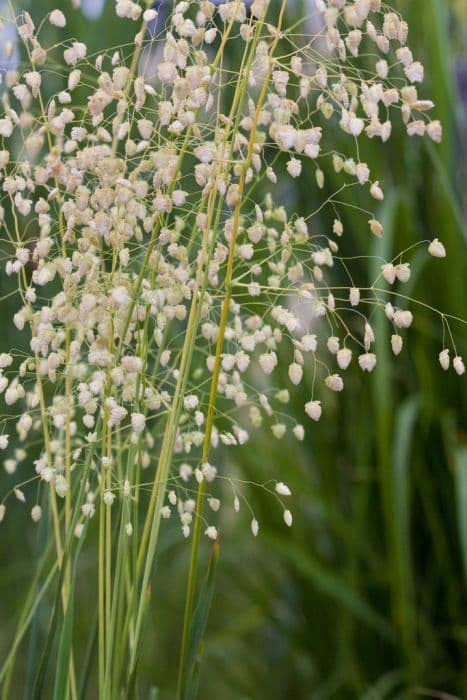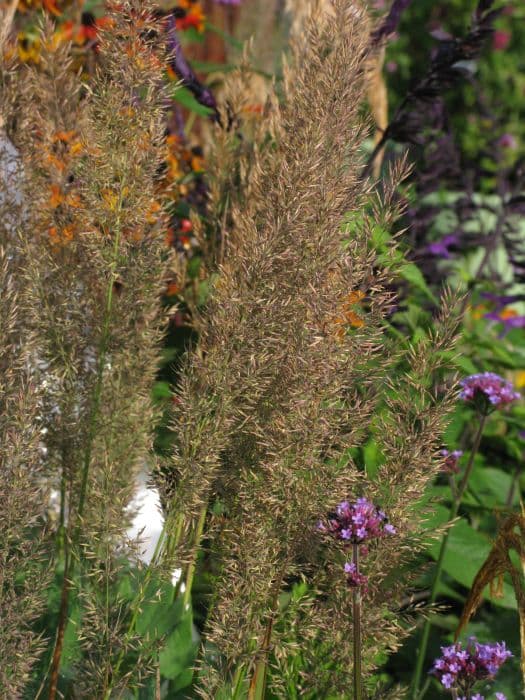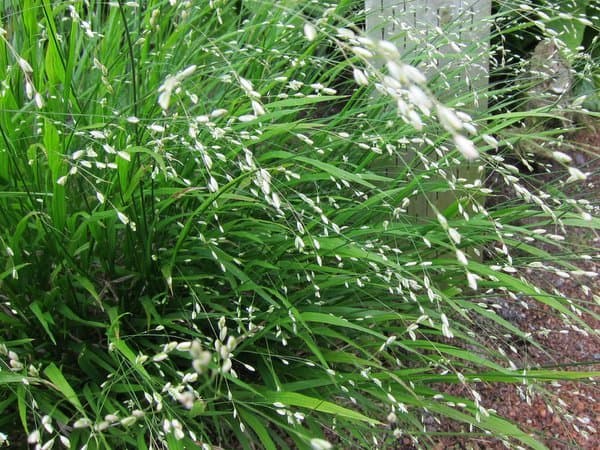Bottlebrush Grass Hystrix patula

ABOUT
Hystrix patula, often referred to as the bottlebrush grass, is characterized by its distinctive flower heads, which bear a strong resemblance to a bottlebrush. This grass typically displays a flowing and tufted appearance, with green, blade-like leaves that are slightly rough to the touch. The leaves are arranged alternately, emerging mainly from the lower part of the plant. As the growing season progresses, the foliage tends to arch and may develop a bluish-green hue. The inflorescence of bottlebrush grass is quite unique and visually striking. It consists of slender, elongated spikes that contain numerous small, bristly flowers. These flowers are typically green or purplish and form dense, bristly clusters that run along the top part of the stems. The appearance of the flowers gives this grass its common name, as they closely resemble the look and texture of a traditional bottle brush used for cleaning. During blooming, the inflorescence adds a soft, textural element to the plant’s appearance, which can be quite eye-catching. After flowering, the seeds of the bottlebrush grass are also visually interesting. They are held tightly within the spiky bristles and persist into the winter months, providing a distinctive look even as other plants die back. The overall appearance of the plant creates a striking profile in the landscape, as it gently sways with the wind, adding movement and interest throughout the seasons.
About this plant
 Names
NamesFamily
Poaceae
Synonyms
Bottlebrush Grass
Common names
Elymus hystrix var. bigeloviana, Elymus hystrix var. patulus, Hystrix bigeloviana, Hystrix patula var. bigeloviana.
 Toxicity
ToxicityTo humans
Hystrix patula is commonly known as bottlebrush grass. As of my last update, bottlebrush grass is not known to be toxic to humans. It does not contain any significant poisons that would cause harm if ingested. Therefore, no symptoms of poisoning are expected upon ingestion of this plant.
To pets
Bottlebrush grass is also not known to be toxic to pets. It does not contain harmful substances that would adversely affect the health of animals if they were to ingest parts of the plant. Like in humans, no symptoms of poisoning are expected in pets due to the ingestion of bottlebrush grass.
 Characteristics
CharacteristicsLife cycle
Perennials
Foliage type
Deciduous
Color of leaves
Green
Flower color
Varies
Height
2-3 feet (0.6-0.9 meter)
Spread
2 feet (0.6 meter)
Plant type
Grass
Hardiness zones
5
Native area
North America
Benefits
 General Benefits
General Benefits- Erosion Control: Hystrix patula, commonly known as bottlebrush grass, has a root system that helps to stabilize soil and prevent erosion.
- Habitat for Wildlife: The plant provides cover and food for local wildlife, including birds and small mammals.
- Aesthetic Appeal: Bottlebrush grass adds a unique texture and form to gardens and landscaped areas, enhancing visual interest.
- Drought Tolerance: It is tolerant of drought conditions once established, reducing the need for irrigation.
- Low Maintenance: Bottlebrush grass typically requires minimal upkeep, making it an ideal choice for low-maintenance landscapes.
- Adaptability: It adapts well to a variety of soil types and environmental conditions, making it a versatile choice for different landscapes.
- Seasonal Interest: The plant provides visual interest throughout the year, with green foliage in spring and summer, and tan to brown colors in fall and winter.
 Medical Properties
Medical PropertiesThis plant is not used for medical purposes.
 Air-purifying Qualities
Air-purifying QualitiesThis plant is not specifically known for air purifying qualities.
 Other Uses
Other Uses- Hystrix patula, commonly known as bottlebrush grass, can be used as a natural dye source; the plant can impart a range of colors to textiles depending on the mordant used.
- The seeds of bottlebrush grass can be used as a filler in hypoallergenic pillows and mattresses, providing an alternative to synthetic materials.
- Because of the plant's aesthetic appeal, dried bottlebrush grass is often incorporated into floral arrangements and rustic décor.
- Bottlebrush grass can serve as erosion control vegetation on slopes and banks due to its dense rooting system.
- The plant's sturdy stems are sometimes used in handcrafts and can be woven into baskets or mats.
- The dense clumps formed by bottlebrush grass can act as natural privacy screens in gardens or along property lines.
- Bottlebrush grass seeds are valuable to wildlife; they can be included in homemade bird seed mixes to attract a variety of birds.
- As a natural mulch, the leaves and stems of the plant can be laid around garden beds to retain soil moisture and suppress weeds.
- The tall stature and swaying movement of bottlebrush grass can be used to add a sound element to garden designs, rustling pleasantly in the breeze.
- The robustness of the plant allows it to be used in phytoremediation efforts to help restore disturbed sites and improve soil health.
Interesting Facts
 Feng Shui
Feng ShuiThe plant Hystrix patula, commonly known as the bottlebrush grass, is not used in Feng Shui practice.
 Zodiac Sign Compitability
Zodiac Sign CompitabilityThe bottlebrush grass is not used in astrology practice.
 Plant Symbolism
Plant Symbolism- Resilience – Hystrix patula, commonly known as the bottlebrush grass, grows in tough conditions and often in poor soil, symbolizing the ability to thrive despite adversity.
- Flexibility – This plant's ability to sway with the breeze without breaking suggests the importance of being adaptable to life's changes.
- Natural Beauty – Bottlebrush grass, with its unique brush-like flower spikes, represents the beauty that can be found in natural, unaltered forms.
- Wildlife Support – As a plant that provides habitat and food for wildlife, it symbolizes the interconnectedness and support of all living things.
 Water
WaterThe most common name for Hystrix patula is bottlebrush grass. Bottlebrush grass should be watered deeply but infrequently to mimic its natural habitat conditions, aiming for a total of about one inch of water per week. Depending on your local climate and soil conditions, this might mean watering once a week or less if rainfall contributes to the plant's moisture needs. It is best to water in the morning or early afternoon to allow the foliage to dry before nightfall, reducing the risk of disease. Always check the top few inches of soil for dryness before watering to prevent overwatering.
 Light
LightBottlebrush grass thrives best in full sun to partial shade. The ideal spot for this plant is an area where it can receive at least six hours of direct sunlight each day, though it can tolerate some light shade, especially during the hottest part of the day. Avoid deep shade as it can lead to poor growth and fewer seed heads.
 Temperature
TemperatureBottlebrush grass prefers a temperate climate and can survive temperatures ranging from about 10°F to 90°F, although it grows best when temperatures are between 60°F and 75°F. It is hardy in USDA zones 3 through 9, tolerating frost and cold winters well.
 Pruning
PruningPruning bottlebrush grass is mainly done to maintain its shape and remove old foliage. It's best to prune in late winter or early spring before new growth begins by cutting the foliage down to a few inches above the ground. This encourages fresh, new growth and prevents self-seeding if that is a concern. Annually pruning is often enough to keep bottlebrush grass looking tidy and vigorous.
 Cleaning
CleaningAs needed
 Soil
SoilBottlebrush grass prefers well-drained soil with a neutral to slightly acidic pH. A mixture of garden soil, peat, and sand in equal parts creates an ideal environment for growth. The best pH range for this plant is approximately 6.0 to 7.0.
 Repotting
RepottingBottlebrush grass, a perennial, doesn't frequently require repotting. It can typically remain in the same spot or container for several years without issue unless it outgrows its space or the soil becomes depleted.
 Humidity & Misting
Humidity & MistingBottlebrush grass thrives in average room humidity conditions. It does not require high humidity and can tolerate the drier air found in most home environments.
 Suitable locations
Suitable locationsIndoor
Place in well-lit area with indirect light; water when top soil feels dry.
Outdoor
Choose a sunny to partial shade spot; water regularly to establish.
Hardiness zone
4-9 USDA
 Life cycle
Life cycleHystrix patula, also known as Bottlebrush grass, begins its life cycle as a seed that germinates in the spring after overwintering in the soil. The seed grows into a seedling, establishing a root system and sending up shoots. As it matures into a young plant, it develops long, narrow leaves and a stem that hardens over time. During the summer, it flowers, producing spikelets that resemble a bottlebrush, which are pollinated by wind. After pollination, seeds develop and are dispersed by wind and animal movement in late summer or autumn. The plant then enters dormancy during the winter, with the cycle restarting the following spring from the new seeds.
 Propogation
PropogationPropogation time
Spring to early summer
Hystrix patula, commonly known as bottlebrush grass, is typically propagated through seed. The most popular method involves collecting the seeds from mature plants in late summer to early fall, after they have dried on the plant. Once collected, the seeds are sown either directly outdoors in the fall, which allows a natural stratification period over winter, or they are sown indoors in early spring after a period of cold moist stratification to break seed dormancy. This stratification process typically involves mixing the seeds with moist sand and placing them in a plastic bag, which is then stored in a refrigerator at about 40 degrees Fahrenheit (approximately 4 degrees Celsius) for a month or two before planting. After the stratification period, the seeds are sown on the surface of a well-draining seed starting mix, as they require light for germination, and kept consistently moist until germination occurs.









